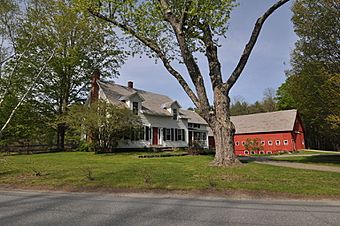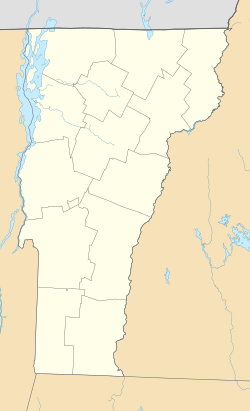Samuel Gilbert Smith Farmstead facts for kids
Quick facts for kids |
|
|
Samuel Gilbert Smith Farmstead
|
|
 |
|
| Location | 375 Orchard St., Brattleboro, Vermont |
|---|---|
| Area | 20 acres (8.1 ha) |
| Built | 1870 |
| MPS | Agricultural Resources of Vermont MPS |
| NRHP reference No. | 00000830 |
| Added to NRHP | July 20, 2000 |
The Samuel Gilbert Smith Farmstead is a special old farm in Brattleboro, Vermont. It's located at 375 Orchard Street. This farm is important because it shows how farms looked and worked in the 1870s. It also has a long history, going back to the 1700s. The farm was added to the National Register of Historic Places in 2000. This means it's a protected historical site.
Contents
What Makes This Farm Special?
The Samuel Gilbert Smith Farmstead is in a quiet, country part of northern Brattleboro. Today, the property is about 20 acres. But long ago, in the 1700s, the farm was much bigger, around 1000 acres!
Exploring the Farm's Features
This historic farm has many interesting parts. You can see open fields with old stone walls. There are also original wells from the 1800s. A small stream flows through the property too.
The Farm Buildings
The main part of the farm is called the farmstead. It includes a house and other buildings connected together. These buildings are a kitchen area, a shed for tools, and a barn. All these buildings were built around 1870. They show a simple, traditional style of building from that time. The house itself has 1-1/2 stories and a sloped roof.
A Journey Through Time: The Farm's History
The story of this farm began a very long time ago, in 1767. A doctor named Henry Wells was given 1000 acres of land here. This land was important for the early town of Brattleboro. It included the town's first cemetery and meeting house.
How the Farm Changed Over Time
Later, the town grew more along its rivers. So, this area became less important for a while. From 1801 to 1815, a famous writer and judge named Royall Tyler owned the farm. He wrote a lot about the property. Back then, the farm was about 150 acres. It had older buildings that were not connected.
Samuel Gilbert Smith's Contribution
In 1850, Samuel Gilbert Smith became the owner of half of the farm. Around 1870, he decided to make a big change. He took down the old farm buildings. Then, he built the connected farmstead that you can see today. This is the set of buildings that are now protected as a historic site.



